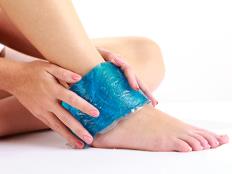
It's the largest tendon in your body; and when it comes to running, it's supremely important. It's the Achilles, a hard-working tendon that is used so much it can be susceptible to injury.
The Achilles tendon connects the calf muscle to the heel bone. Common injuries to the Achilles includes both tendonitis and tendonosis. The symptoms are similar between these two conditions, but the timing varies. Achilles tendonitis tends to be an acute injury, while tendonosis nags at the Achilles over time in a more chronic manner.
"It seems to be common among runners and I see this quite often in the clinic," says Lara Johnson , a physical therapist and competitive runner based in Boulder, Colorado. "I think it's frustrating because it can be one of those lingering issues that just doesn't seem to go away."
In the beginning, symptoms usually include stiffness in the Achilles region, along with a mild ache. Over time, pain can increase, especially if you continue to run. "You may also experience accompanying calf tightness and sometimes heel or foot pain due to altered force distribution in the foot and ankle," Johnson says.
More: 3 Ways to Prevent Achilles Tendonitis
The pain associated with Achilles tendonitis is caused by excess strain on the tissue that connects the calf muscle to the heel bone. In runners, it often stems from too much of the wrong kind of training over time. For instance, when you put in too many miles too soon, Achilles tendonitis might be the first sign that you've been overdoing things. Similarly, excessive hill running or sprints done without warming up properly can lead to Achilles tendonitis.
Footwear and terrain can also be a culprit. Running in worn out shoes or wearing an ill-fitting model can cause damage. Excessive treadmill mileage or too much pavement pounding can also aggravate the Achilles.
Other issues throughout the kinetic chain can also lead to Achilles issues.
"Musculoskeletal contributors to this tendon tissue restriction may include calf tightness at either or both calf muscles, and/or foot and ankle joint dysfunction, and/or alignment dysfunction higher up the chain that can alter the way your foot strikes the ground," Johnson says.
In the end, Johnson finds with many of the runners she works with the cause isn't cut and dry.
"Often with runners, with all these potential factors, there is likely not just one thing to address," Johnson says. "It is often a combination of multiple factors and we must not only address the symptoms, but the source of the problem, such as training and tissue integrity."
- 1
- of
- 2
About the Author

Get ACTIVE on the Go


Couch to 5K®
The best way to get new runners off the couch and across the finish line of their first 5K.
Available for iOS | Android







Discuss This Article